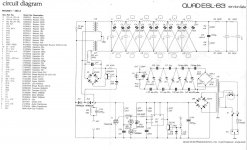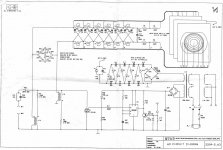Hi,
I get a shock every time I connect a Class D amp that doesn't have an earth connection. I don't know where the voltage comes from. It measures around 60VDC. The strangest thing is that the electrical leakage is only there when I connect it to the ESL. If I connect it to a boxed speaker, it fine.
Do you do earth connection on your ESL? If yes, how do you do it?
Wachara C.
I get a shock every time I connect a Class D amp that doesn't have an earth connection. I don't know where the voltage comes from. It measures around 60VDC. The strangest thing is that the electrical leakage is only there when I connect it to the ESL. If I connect it to a boxed speaker, it fine.
Do you do earth connection on your ESL? If yes, how do you do it?
Wachara C.
Hi,
depending on the design there is voltage inducted into the primary windings by the secondary windings of the stepup transformer. The High voltage supply is typically a cascade run by AC. Although ist converted to DC there is remaining Ripple on the current. This ripple runs through both secondary windings, causing induction into the primary winding.
Funny thing is, the better the coupling of the stepup the worse the issue. Up to 60 Volts is possible. If the connected amp is not grounded, static upload of the amp will happen. This can be dangerous if the amp has some IC controllers for display or other electronic features. The static charge can easily kill your IC circuits.
One way is to put an Capacitor with sufficient DC rate in serie to the stepup. it will block the DC charge to the amp. Unfortunately this cap needs to be high value in order not to limit bass response and high quality for sound.
Capaciti
depending on the design there is voltage inducted into the primary windings by the secondary windings of the stepup transformer. The High voltage supply is typically a cascade run by AC. Although ist converted to DC there is remaining Ripple on the current. This ripple runs through both secondary windings, causing induction into the primary winding.
Funny thing is, the better the coupling of the stepup the worse the issue. Up to 60 Volts is possible. If the connected amp is not grounded, static upload of the amp will happen. This can be dangerous if the amp has some IC controllers for display or other electronic features. The static charge can easily kill your IC circuits.
One way is to put an Capacitor with sufficient DC rate in serie to the stepup. it will block the DC charge to the amp. Unfortunately this cap needs to be high value in order not to limit bass response and high quality for sound.
Capaciti
Hi,
depending on the design there is voltage inducted into the primary windings by the secondary windings of the stepup transformer. The High voltage supply is typically a cascade run by AC. Although ist converted to DC there is remaining Ripple on the current. This ripple runs through both secondary windings, causing induction into the primary winding.
Funny thing is, the better the coupling of the stepup the worse the issue. Up to 60 Volts is possible. If the connected amp is not grounded, static upload of the amp will happen. This can be dangerous if the amp has some IC controllers for display or other electronic features. The static charge can easily kill your IC circuits.
One way is to put an Capacitor with sufficient DC rate in serie to the stepup. it will block the DC charge to the amp. Unfortunately this cap needs to be high value in order not to limit bass response and high quality for sound.
Capaciti
Hello Michael,
Does a neon oscillator output (like quad uses) improve something on the latter?
MartinJan
Do you do earth connection on your ESL? If yes, how do you do it?
Hi Wachara,
take a look at the Quad Esl-63 schematics.
Quad used a grounded arrangement in the 80s. But later they changed to a floated ground.
Harry
Attachments
Hi,
depending on the design there is voltage inducted into the primary windings by the secondary windings of the stepup transformer. The High voltage supply is typically a cascade run by AC. Although ist converted to DC there is remaining Ripple on the current. This ripple runs through both secondary windings, causing induction into the primary winding.
Funny thing is, the better the coupling of the stepup the worse the issue. Up to 60 Volts is possible. If the connected amp is not grounded, static upload of the amp will happen. This can be dangerous if the amp has some IC controllers for display or other electronic features. The static charge can easily kill your IC circuits.
One way is to put an Capacitor with sufficient DC rate in serie to the stepup. it will block the DC charge to the amp. Unfortunately this cap needs to be high value in order not to limit bass response and high quality for sound.
Capaciti
Hi Capaciti,
Thanks for your input.
The electrical leakage might not have come from the ESL. I tested the ESL when not connecting to any amp, the primary side of the transformer doesn't have any voltage. I'm not sure when it comes from though. The bias voltage of my class D amp is only 12 V. 😕
Using a coupling capacitor is an interesting idea. Do you use it on your ESL as well?
Wachara C.
Hi Harry,
Thank you very much for your diagrams. Do you know the reason why they changed to floated ground in the later version of their 63?
Wachara C.
Thank you very much for your diagrams. Do you know the reason why they changed to floated ground in the later version of their 63?
Wachara C.
Do you know the reason why they changed to floated ground in the later version of their 63?
Don't know exactly. But in the early eighties Quad had problems (sparks) with earthing connections inside the speaker. It this is the case, the very sensitive "sniffer-circuit" will of course shut down the speaker too often.
Harry
- Status
- Not open for further replies.
- Home
- Loudspeakers
- Planars & Exotics
- Do you earth your ESL?

